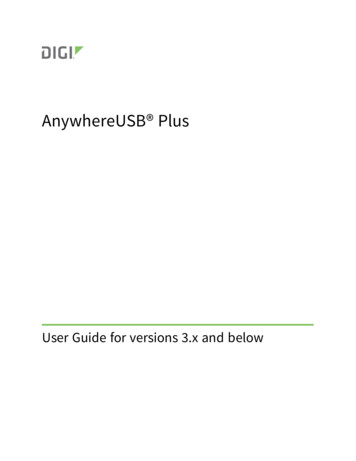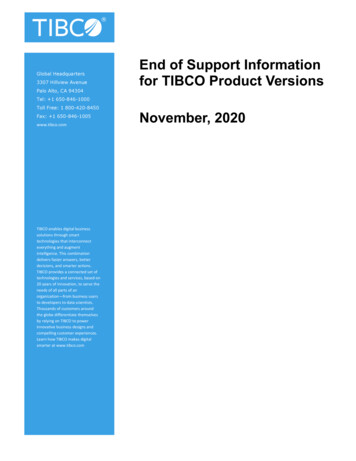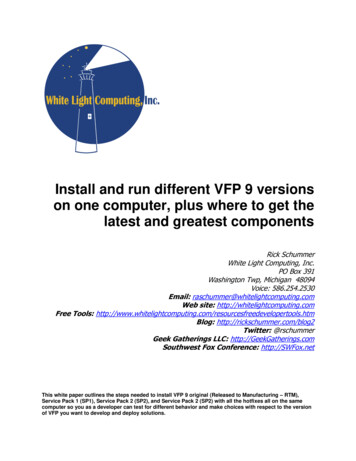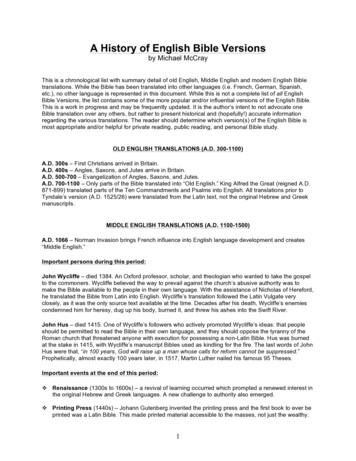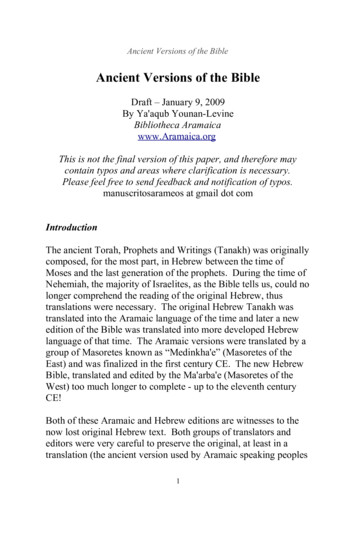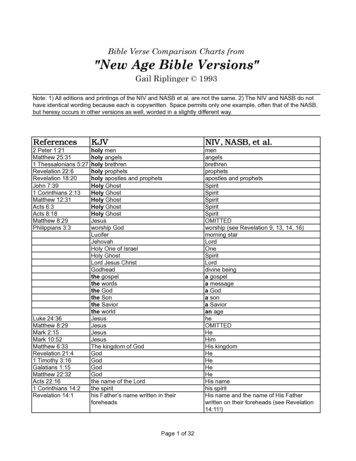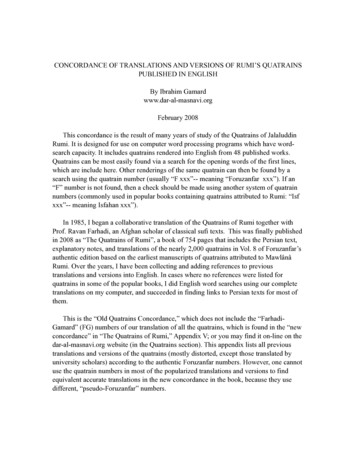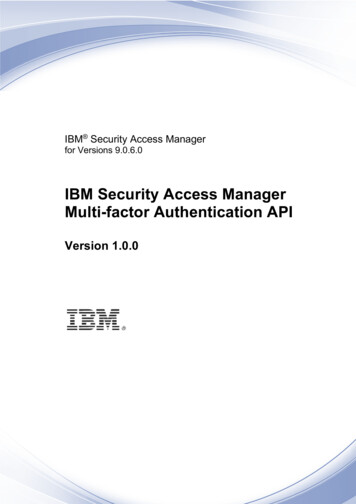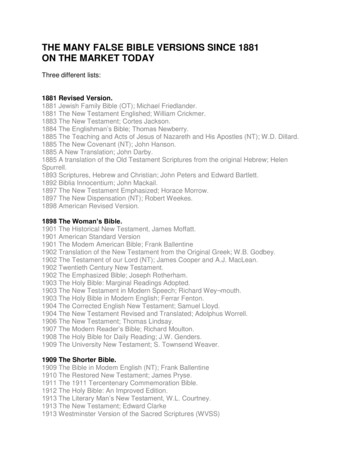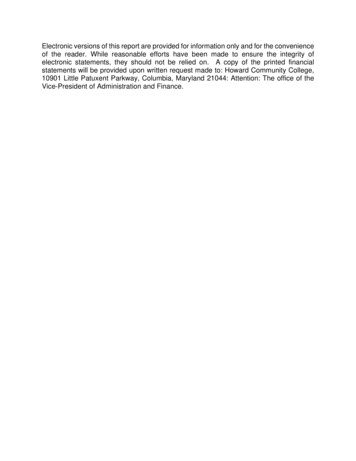
Transcription
Electronic versions of this report are provided for information only and for the convenienceof the reader. While reasonable efforts have been made to ensure the integrity ofelectronic statements, they should not be relied on. A copy of the printed financialstatements will be provided upon written request made to: Howard Community College,10901 Little Patuxent Parkway, Columbia, Maryland 21044: Attention: The office of theVice-President of Administration and Finance.
HOWARD COMMUNITY COLLEGE(A Component Unit of Howard County, Maryland)Financial Statements andReport of Independent Public AccountantsFor the Year Ended June 30, 2017
HOWARD COMMUNITY COLLEGETable of ContentsREPORT OF INDEPENDENT PUBLIC ACCOUNTANTS1MANAGEMENT’S DISCUSSION AND ANALYSIS3FINANCIAL STATEMENTSStatement of Net Position34Statement of Revenue, Expenses and Changes in Net Position36Statement of Cash Flows38Notes to the Financial Statements40REQUIRED SUPPLEMENTARY INFORMATIONSchedule of Howard Community College Proportionate Share ofthe Net Pension Liability - Maryland State Retirement andPension Systems68Schedule of Howard Community College’s Contributions Maryland State Retirement and Pension Systems69Notes to Required Supplementary Information70
REPORT OF INDEPENDENT PUBLIC ACCOUNTANTSTo the Board of TrusteesHoward Community College Columbia, MarylandReport on the Financial StatementsWe have audited the accompanying financial statements of Howard Community College (theCollege), a component unit of Howard County, Maryland, and its discretely presented component unit,the Howard Community College Educational Foundation, Inc., as of and for the year ended June 30,2017, and the related notes to the financial statements, which collectively comprise the College’s basicfinancial statements as listed in the table of contents.Management’s Responsibility for the Financial StatementsManagement is responsible for the preparation and fair presentation of these financial statementsin accordance with accounting principles generally accepted in the United States of America; thisincludes the design, implementation, and maintenance of internal control relevant to thepreparation and fair presentation of financial statements that are free from material misstatement,whether due to fraud or error.Auditor’s ResponsibilityOur responsibility is to express an opinion on these financial statements based on our audit. Weconducted our audit in accordance with auditing standards generally accepted in the UnitedStates of America. Those standards require that we plan and perform the audit to obtainreasonable assurance about whether the financial statements are free from material misstatement.An audit involves performing procedures to obtain audit evidence about the amounts anddisclosures in the financial statements. The procedures selected depend on the auditor’s judgment,including the assessment of the risks of material misstatement of the financial statements, whetherdue to fraud or error. In making those risk assessments, the auditor considers internal controlrelevant to the entity’s preparation and fair presentation of the financial statements in order todesign audit procedures that are appropriate in the circumstances, but not for the purpose ofexpressing an opinion on the effectiveness of the entity’s internal control. Accordingly, weexpress no such opinion. An audit also includes evaluating the appropriateness of accountingpolicies used and the reasonableness of significant accounting estimates made by management,as well as evaluating the overall presentation of the financial statements.200 International Circle Suite 5500 Hunt Valley Maryland 21030 P 410.584.0060 F 410.584.0061
We believe that the audit evidence we have obtained is sufficient and appropriate to provide a basisfor our audit opinion.OpinionIn our opinion, the financial statements referred to above present fairly, in all material respects, thefinancial position of the business-type activities and the discretely presented component unit of theCollege as of June 30, 2017, and the respective changes in their financial position and their cash flowsfor the year then ended in accordance with accounting principles generally accepted in the UnitedStates of America.Other MattersRequired Supplementary InformationAccounting principles generally accepted in the United States of America require that themanagement’s discussion and analysis and Schedule of Howard Community College ProportionateShare of the Net Pension Liability - Maryland State Retirement and Pension Systems and theSchedule of Howard Community College’s Contributions - Maryland State Retirement and PensionSystems be presented to supplement the basic financial statements. Such information, althoughnot a part of the basic financial statements, is required by the Governmental Accounting StandardsBoard, who considers it to be an essential part of the financial reporting for placing the basicfinancial statements in an appropriate operational, economic, or historical context. We have appliedcertain limited procedures to the management’s discussion and analysis and required supplementaryinformation in accordance with auditing standards generally accepted in the United States ofAmerica, which consisted of inquiries of management about the methods of preparing theinformation and comparing the information for consistency with management’s responses to ourinquiries, the basic financial statements, and other knowledge we obtained during the audit of thebasic financial statements. We do not express an opinion or provide any assurance on the informationbecause the limited procedures do not provide us with sufficient evidence to express an opinionor provide any assurance.Hunt Valley, MarylandSeptember 19, 20172
HOWARD COMMUNITY COLLEGEManagement’s Discussion and AnalysisJune 30, 2017Overview and Basis of PresentationThe following discussion and analysis provides an overview of Howard Community College’s(referred to throughout as the “college” or “HCC”) planning, enrollment, and financialactivities. The intent of this section of the annual financial report is to provide an objectiveanalysis of the college’s financial activities based on currently known facts, decisions, orconditions that impacted the operations of the college during fiscal year (FY) 2017. Inaddition, this section should assist in assessing the financial position of the college andprovide information about significant changes that have occurred. Finally, it presents anoutlook on known conditions that may affect the college’s financial position or operations inthe coming years.The college has presented the statements in compliance with the Governmental AccountingStandards Board (GASB) statement no. 34, Basic Financial Statements and Management’sDiscussion and Analysis for State and Local Governments, and statement no. 35, BasicFinancial Statements and Management’s Discussion and Analysis for Public Colleges andUniversities.In compliance with GASB statement no. 39, Determining Whether Certain Organizations areComponent Units, the financial statements of the Howard Community College EducationalFoundation, Inc. (referred to throughout as the “foundation” or “HCCEF”) are presenteddiscretely in the college’s financial statements.Comparative financial data are not presented in the financial statements; however, thecollege’s comparative data are presented and discussed within this management discussionand analysis.College Planning and Strategic GoalsThe financial statements for the year ended June 30, 2017, reflect the financial results of theactivities of the college, which are guided by the college’s strategic planning and budgetprocess. The strategic plan and the college’s core work set the stage for the operational andfinancial goals the college expects to achieve. Long- and short-term goals guide the staffthroughout the year and into the future. The college’s mission, vision, and values follow.Mission: Providing pathways to successVision: A place to discover greatness in yourself and othersValues: INSPIRES3
HOWARD COMMUNITY COLLEGEManagement’s Discussion and AnalysisJune 30, 2017College Planning and Strategic Goals (continued)The strategic goals implemented for a five-year period, 2016-2020, with 2016 being the baseyear, are listed on the next set of pages. Each year during the budget process, funds areallocated to achieve these initiatives. The report includes the action plans in place for FY17and the fiscal year accomplishments related to these action plans that impacted the college’sfinancial operations.4
HOWARD COMMUNITY COLLEGEManagement’s Discussion and AnalysisJune 30, 20175
HOWARD COMMUNITY COLLEGEManagement’s Discussion and AnalysisJune 30, 20176
HOWARD COMMUNITY COLLEGEManagement’s Discussion and AnalysisJune 30, 20177
HOWARD COMMUNITY COLLEGEManagement’s Discussion and AnalysisJune 30, 20178
HOWARD COMMUNITY COLLEGEManagement’s Discussion and AnalysisJune 30, 20179
HOWARD COMMUNITY COLLEGEManagement’s Discussion and AnalysisJune 30, 201710
HOWARD COMMUNITY COLLEGEManagement’s Discussion and AnalysisJune 30, 201711
HOWARD COMMUNITY COLLEGEManagement’s Discussion and AnalysisJune 30, 201712
HOWARD COMMUNITY COLLEGEManagement’s Discussion and AnalysisJune 30, 201713
HOWARD COMMUNITY COLLEGEManagement’s Discussion and AnalysisJune 30, 201714
HOWARD COMMUNITY COLLEGEManagement’s Discussion and AnalysisJune 30, 201715
HOWARD COMMUNITY COLLEGEManagement’s Discussion and AnalysisJune 30, 201716
HOWARD COMMUNITY COLLEGEManagement’s Discussion and AnalysisJune 30, 201717
HOWARD COMMUNITY COLLEGEManagement’s Discussion and AnalysisJune 30, 201718
HOWARD COMMUNITY COLLEGEManagement’s Discussion and AnalysisJune 30, 2017College Planning and Strategic Goals (continued)The following are some core work accomplishments that occurred during the fiscal year thatimpacted FY17 revenue and spending: Advocated successfully for the college’s legislative agenda with federal, state, andlocal governments;Provided 1,592,804 in overall support for scholarships and programs from thefoundation to the college ( 1,106,506 for scholarships and 486,298 for programs);Collaborated with web services, the Laurel College Center (LCC) and PrinceGeorge’s Community College in the development and launch of a new mobilefriendly, prospective student-oriented LCC website;Launched first-ever digital advertising campaign for the LCC, as a result of the newLCC website;Leveraged the college’s new SET building to create a public relations and marketingcommunications campaign around science, technology, engineering, andmathematics (STEM) education at HCC, which included a digital marketingcampaign, new web microsite to showcase the academics in the building, and aPathways magazine focused exclusively on STEM;Won a 2 million contract from NSA (National Security Agency) to deliver incontinuing education and workforce development contract training courses;Established a dual enrollment partnership with the Howard County Chinese School(HCCS) and are working on creating more partnerships with private organizationsand schools to extend dual enrollment capacity to organizations and schools outsidethe Howard County Public School System;Received a three-year, 215,158 grant from National Science Foundation (NSF)grant to develop an entertainment technology program and certificate;Developed a new certificate program in additive manufacturing to train students inthis new technology and to prepare them for employment in a variety of technicalsectors;Served community wellness/health initiatives by serving over 250 patients with theirdental hygiene and cancer screening. 100 percent of the HS division participated.Hosted and participated in the annual MANS (Maryland Association of NursingStudents) State Convention (over 200 students and professionals from 25 othercolleges and medical organizations);Launched an integrated reading and writing pre-college Developmental EnglishCourse with redesign/alignment of developmental and college English curriculum aswell as restructured English and World Language adjunct faculty and lab instructortraining/feedback; and,Completed construction of the East Garage expansion;Completed construction of the new SET building and moved into the building in May2017.Redesigned the credit schedule to eliminate course conflicts and to expand courseofferings by 12 percent;Completed compensation study and issued salary letters to all employees;19
HOWARD COMMUNITY COLLEGEManagement’s Discussion and AnalysisJune 30, 2017College Planning and Strategic Goals (continued) Completed first full year of bookstore management by Barnes & Noble andexperienced an estimate of 440,000 in cost savings to students for the year inrental, digital, and used title formats;Reduced the Sodexo subsidy for a total annual savings of 52,397 over FY16;Developed and updated internal policies and procedures to address legislation forTitle IX, Clery Act and registered sex offenders, Stop the Bleed campaign, andHeroin and Opioid Addiction and Prevention;Implemented MVIEW and utilized grant opportunity for Maryland and NationalCapital Region Interoperable CCTV video streaming capability for enhanced campussafety in coordination with Maryland State Police, Howard County Police, andDepartment of Homeland Security; and,Ranked third nationally by Center for Digital Education for the college’s use ofinformation technology to deliver services to students, faculty, and staff;In collaboration with student services, completed the implementation of financial aidself-services for students’ online access to financial aid awards and information;Installed computer security technology and applications and completed securityaudits in a continuous effort to improve college’s technology infrastructure protectionfrom malicious attacks and data loss;Completed network and infrastructure upgrades including upgrades to the campuswireless network, additional firewall, email encryption solution and upgraded 1,200staff and student computers;Continued Structured Query Language (SQL) database migration project for thecollege’s administrative computer system, which impacts all business process andservices on campus;Implemented Virtual Advising;Launched a waitlist for the majority of credit courses at HCC;Revised financial aid packaging criteria for a more targeted approach for tuition,fees, and books for in-county students with high and moderate financial need;Welcomed the first Early College Cohort students (Cybersecurity) to HCC as fulltime students while completing their senior year of high school;Created a structure to provide financial aid support to Howard Pride, Ambiciones,and Career Links students;Served 404 HCC students through the HCC Food Pantry;Completed the Maryland State Department of Education’s validation process forearly childhood programs and was accredited for three years;Hosted the National Junior College Athletic Association (NJCAA) Outdoor Division IIITrack National Championships;The Safe Zone Committee collaborated with Dragon Digital Media to create, It GetsBetter at Howard Community College, a video that features students, faculty, andstaff supporting and encouraging the Lesbian, Gay, Bi-Sexual, and Transgendercommunity. The video won an International Accolade award;The Career Center connected with 343 employers, an 88.5 percent increase,compared to FY16 (182);20
HOWARD COMMUNITY COLLEGEManagement’s Discussion and AnalysisJune 30, 2017College Planning and Strategic Goals (continued) Enrolled the highest percentage of students with disabilities in credit courses in thestate according to the Maryland Association of Community Colleges databook;Counseling services improved its national comparison of pre-post change, usingdata from the Counseling Center Assessment of Psychological Symptoms (CCAPS),personal counseling clients with moderate and/or elevated distress on the AcademicDistress Scale of the CCAPS, achieving an improvement that was greater than 97percent of other counseling centers.21
HOWARD COMMUNITY COLLEGEManagement’s Discussion and AnalysisJune 30, 2017Enrollment Statistics and AnalysisFor the year ended June 30, 2017, the college served approximately 14,220 credit and 15,674noncredit students. Student enrollment data is defined and reported annually to the MarylandHigher Education Commission in terms of full-time equivalent (FTE) students; FTE represents30 hours of instruction. FTE is an important statistic of the college as it is the basis forcomparison among the various state colleges and is, in part, what determines the college’sstate funding.During FY17, the state approved credit and noncredit enrollments of 6,071.21 and 1,353.33FTE. As compared to the prior year, this is a decrease of 118.56 credit FTE, however, it isan increase of 27.83 in noncredit FTE. State-funded FTE do not include out-of-state students,employees who took classes, and other ineligible students determined by the state. Overall,credit FTE of 6,308.27 decreased 77.46 FTE, or 1.2 percent. Noncredit FTE of 1,729.86decreased 6.52, or .4 percent. Together this number created a total decrease in FTE of83.98, or one percent. The college had anticipated enrollment to be flat in FY17. Nationwide,community colleges are experiencing declining enrollment as the improving economy attractsmore people into the workforce and birthrates drop.The chart below shows total FTE as opposed to state-funded FTE for fiscal years 2013through 2017.7,000.006,000.005,000.004,000.00Credit FTE students3,000.00Noncredit FTE creditTotal ,540.961,714.628,255.586,528.331,746.898,275.22As seen in the data above, the FTE decline was 2.9 percent for this five-year period. Nogrowth in credit or noncredit enrollment is anticipated in the FY18 budget.22
HOWARD COMMUNITY COLLEGEManagement’s Discussion and AnalysisJune 30, 2017Economic ImpactThe college’s economic stability comes primarily from three revenue sources: tuition and feesfrom students, and funding appropriations from Howard County Government and the State ofMaryland. The original intent was that one-third of the college’s operating funds would comefrom each of these sources; however, in FY17, the actual unrestricted revenue was 42percent from students, 35 percent from the county, and 19 percent from the state, with thefinal four percent coming from auxiliary and miscellaneous revenue.Although the college’s per credit hour tuition rate increased by two dollars per credit hour,the student share of actual unrestricted revenue declined by one percent. This is the result ofthe one percent enrollment decline in FY17.State funds are distributed through the Cade funding formula, with the community collegesreceiving a percentage of what the four-year institutions receive in funding from the state.Due to the improving state economy, the state was able to increase the college’s operatingappropriation by eleven percent, or 1,688,521 over the FY16 budget. This increasesubsequently improved the state’s share of actual unrestricted revenue by two percent overthe prior year.The college received a four percent, or 1,240,011 increase in FY17 operating funding fromthe county. This increase, therefore, increased the county’s actual unrestricted share ofrevenue by one percent over the prior year.The auxiliary and miscellaneous revenue declined by two percent. This reduction is primarilydue to outsourcing the college’s bookstore operations, which decreased gross revenue. Thecommissions from the bookstore’s outsourcing contract have improved the auxiliaryoperations bottom line.Financial Statement Highlights and AnalysesThe financial statements, as prepared in accordance with GASB S
(HCCS) and are working on creating more partnerships with private organizations . dental hygiene and cancer screening. 100 percent of the HS division participated. Hosted and participated in the annual MANS (Maryland Association of Nursing Students) State Conventi
